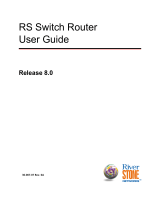Page is loading ...

Page 1 of 2
Product Brief
Product Model
Product ModelProduct Model
Product Model
IpLink™ Model 2888
Product Name
Product NameProduct Name
Product Name
Multi-Megabit Inverse Mux
Usage
UsageUsage
Usage
Transparent Ethernet Extender over Bonded T1/E1 Circuits
Product
Description
The Model 2888 Multi-Megabit Inverse Mux is a managed Ethernet bridge
with two (2) Gigabit Ethernet ports and either two (2) or four (4) T1/E1
ports. The Inverse Mux transports jumbo Ethernet frames over bonded T1/E1
circuits using Multi-link PPP, creating up to an 8 Mbps transparent Ethernet
connection. Complete with Layer 2/3 filtering, Layer 2/3 traffic shaping and
Active Layer 2/3 QoS, the Model 2888 enhances an enterprise’s ability to
address the Wide Area Network (WAN) bandwidth requirements of most
Ethernet applications.
Who is it for?
The Model 2888 Multi-Megabit Inverse Mux is designed to bridge the Ethernet/IP bandwidth gap between a single
T1/E1 and a T3/E3. Bandwidth hungry applications such as database/Intranet, VoIP and surveillance video over IP that
need to be transported over the WAN will benefit from a resilient multi-circuit solution.
Position Statement
For enterprise IT Managers needing to bridge the
bandwidth gap between a single T1/E1 and a T3/E3,
the IpLink™ Multi-Megabit Inverse Mux transparently
transports Ethernet over bonded T1/E1 circuits.
Unlike solutions from Cisco and others, which are
difficult to configure, the Multi-Megabit Inverse Mux
makes it easy to transparently pass ALL Ethernet
frames over the WAN while applying ACTIVE Layer
2/3 QoS, traffic shaping and filtering.
Feature Benefit Summary
Feature
Advantage
Benefit
Bonded T1/E1
Bridge the bandwidth gap
between
a single T1/E1 and a T3/E3
Provide symmetric high
-
speed
network
interfacing that is affordable to and
right-sized for the application’s need
Transparent
Ethernet Bridging
Transparently bridge Ethernet traffic
and pass any application traffic
Avoid complicated IP routing
configurations needed to create
redundancy
Active QoS
Provide
the managed tools to ensure
network up-time & application
availability to different traffic flows
Guarantee real
-
time application services
with bandwidth on demand
Enterprise WAN Access Solutions

Page 2 of 2
Product Brief
Solution Description
As enterprise IT managers leverage the convergence of voice, video and data over Ethernet, the need to transport
Ethernet over the WAN at speeds greater than a single T1/E1 increases. Avoid switching to an expensive T3/E3 circuit,
transitioning to an unproven Ethernet based WAN service or spending endless hours configuring IP routing redundancy.
Use the Model 2888 to bond multiple T1/E1 circuits and increase point-to-point Ethernet bandwidth without
overcomplicating configurations or sacrificing resiliency.
Problem
Issue
Impact
Our Solution
Need faster
point-to-point
connections
A single T1/E1 is not
fast enough any more
T1/E1 alternatives
introduce cost, risk,
complexity and are
not available
everywhere
Stick with well
-
known
&
reliableT1/E1 circuits and
bond them together for
maximum bandwidth
Complex Router
Configurations
Configuring IP load
balancing is complex
Increases risk router
is misconfigured
Simplify by bridging
Ethernet traffic over the
WAN
Prioritizing some
applications over
others
Real
-
time applications
need dedicated
bandwidth and higher
priority
Without active QoS
voice and video
applications will be
unusable
Apply active layer 2/3 QoS
and guarantee applications
the bandwidth they need
Unique Selling Position
The IpLink™ Model 2888 Multi-Megabit Inverse Mux increases point-to-point Ethernet/IP bandwidth over standard
T1/E1 circuits, reducing configuration complexity, and providing active QoS for real-time application requirements.
Top
FAQ
s
Q. If all my traffic
Q. If all my traffic Q. If all my traffic
Q. If all my traffic is IP why should I use Ethernet bridging?
is IP why should I use Ethernet bridging?is IP why should I use Ethernet bridging?
is IP why should I use Ethernet bridging?
A.
A.A.
A. The other alternative, configuring a router for load-balancing can be a difficult task. First of all, a router can load
balance outbound traffic only. To get bidirectional load balancing requires complex configuration at both ends.
Secondly, both routers must be configured to assign the same administrative distance and cost to a destination. Lastly,
load balancing at the IP packet layer creates a situation where packets can reach the destination out of order, creating a
problem for streaming media such as video. By using Ethernet bridging and relying on ML-PPP, the configuration is
simplified and the out of order packet problem eliminated.
Q. What happens if one of my T1/E1 fails, does my entire link go down?
Q. What happens if one of my T1/E1 fails, does my entire link go down?Q. What happens if one of my T1/E1 fails, does my entire link go down?
Q. What happens if one of my T1/E1 fails, does my entire link go down?
A.
A.A.
A. No, with ML-PPP, if a T1/E1 goes down, the Ethernet traffic will continue to flow across the active links. When the
failed link comes back up, full bandwidth is automatically restored without manual intervention.
Q. Does the Inverse Mux use ATM
Q. Does the Inverse Mux use ATM Q. Does the Inverse Mux use ATM
Q. Does the Inverse Mux use ATM to multiplex the T1/E1 circuits?
to multiplex the T1/E1 circuits?to multiplex the T1/E1 circuits?
to multiplex the T1/E1 circuits?
A.
A.A.
A. No. The Inverse Mux uses Multi-Link PPP (ML-PPP) which is 18% more efficient than ATM when using 256 byte
packets. Efficiency increases further with packet sizes of over 1,000 bytes which are typically used by streaming video.
Q.
Q. Q.
Q. Does the IpLink
Does the IpLinkDoes the IpLink
Does the IpLink™
™™
™
Inverse Mux support VLANs
Inverse Mux support VLANsInverse Mux support VLANs
Inverse Mux support VLANs?
??
?
A.
A.A.
A. Yes. The Inverse Mux can be configured to apply QoS based on VLAN tags as well as tag untagged VLAN traffic. It
can likewise transparently pass VLAN, Cisco ISL and MAC-in-MAC (PBB) frames as well as MPLS tagged traffic.
/
